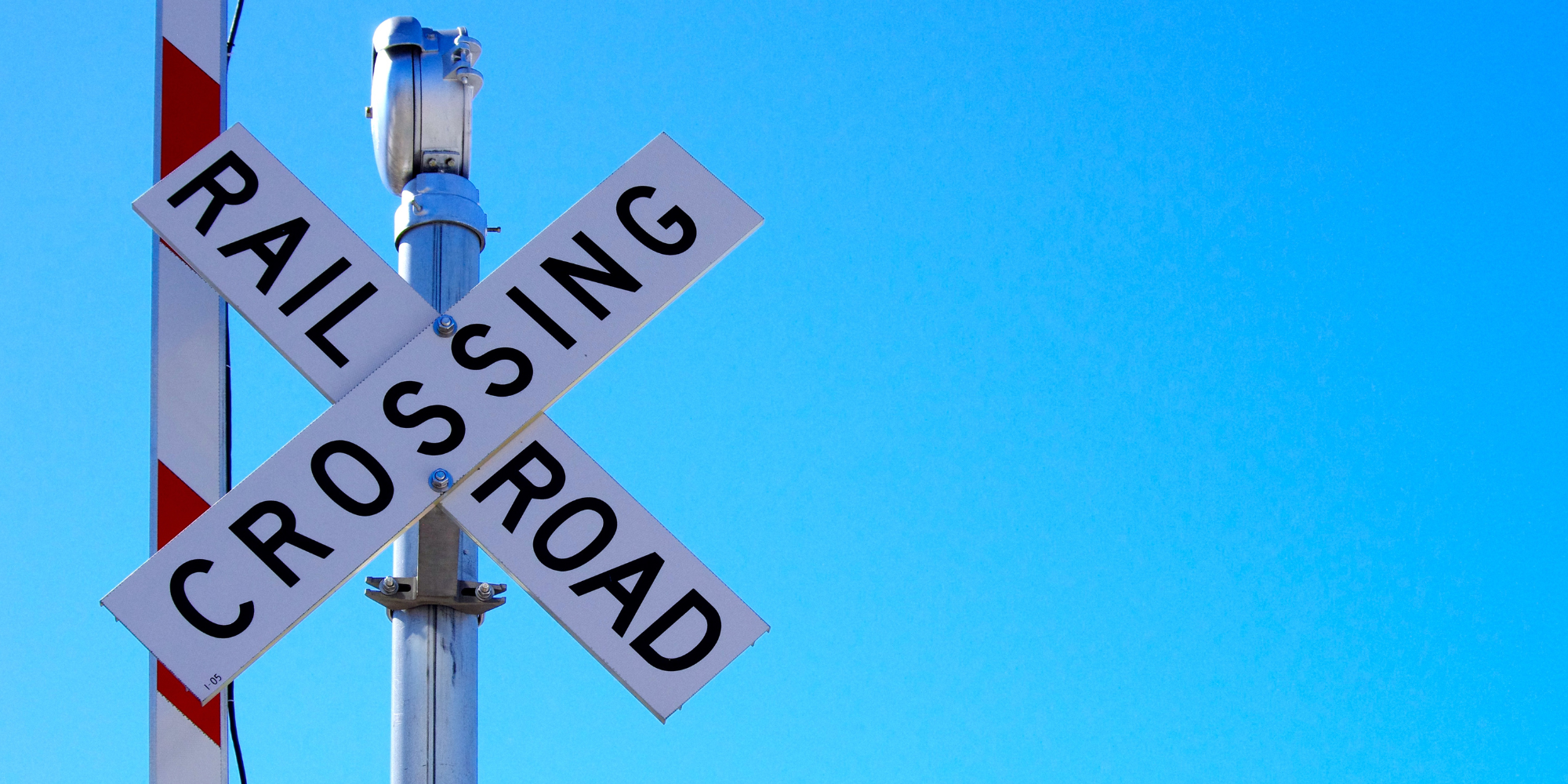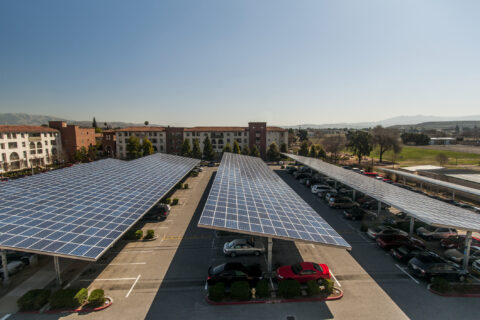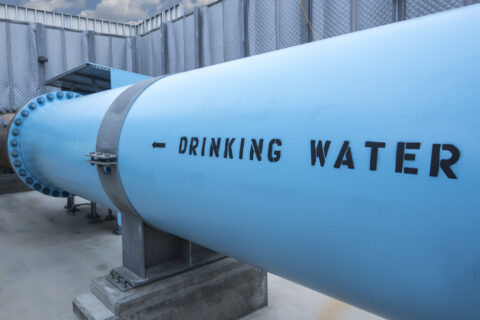Most American cities have active and historic rail train tracks in their backyards. Far before most highways, America’s railroads crisscrossed our country, arriving in small and large cities alike, shaping our travel patterns and land development. However, as America has grown, how many people live near and cross those tracks daily has changed along with how long and often trains are zipping by these communities.
For communities, reaching zero deaths on our roads (known as Vision Zero) also applies to crossing railroad tracks. Sadly, last year there were 881 injuries or deaths at rail crossings in communities. Pedestrians’ deaths accounted for 41 percent of these while 54 percent deaths occurred in motor vehicles as they crossed a railroad.
While many communities have updated their crossings for safety or built over or under to deconflict road and train traffic, far more rail crossings in the U.S. need upgrades to keep the community safe, allow for quiet zones to be established, or even to be eliminated through upgrades.
Rail Grant Opportunities for Communities
America’s communities now have three rail crossing programs they can access directly from the U.S. Department of Transportation (USDOT) as well as each state’s rail safety program. The most well-known is the USDOT’s INFRA grants program (formally, the Nationally Significant Multimodal Freight and Highways Projects program) which just completed an application cycle as part of USDOT’s Multimodal Project Discretionary three-in-one grant application process. INFRA can cover a large number of eligible multimodal uses including rail grade separation projects, but it is highly competitive and often a bigger grant than is needed for a single crossing project. Competitive projects are those that improve safety, generate economic benefits, reduce congestion, enhance resiliency, and hold the greatest promise to eliminate freight bottlenecks and improve critical freight movements.
Due to the outcry for targeted assistance on rail crossings in local communities, Congress formed and appropriated $3 billion in a brand new competitive grant funding in the Railroad Crossing Elimination Grant (RCE) program in the Bipartisan Infrastructure Law (BIL) to improve the safety of people and goods at rail crossings. USDOT’s Federal Railway Administration (FRA) will administer $600 million in RCE grants this year, and USDOT reports these new grants will be available in June. RCE Grants are required by Congress to not be smaller than one million dollars unless they are for planning, and each grant requires a minimum 20 percent non-federal matching share by the entity requesting the grant. Also, at least 20 percent of funds are reserved for projects located in rural areas or on Tribal lands, and even places with very, very few residents have a good shot at these funds – no less than 5 percent of these funds are reserved for projects in counties with 20 or fewer residents per square mile. Local governments, Metropolitan Planning Organizations (MPOs), a mix of local governments or a combo of local and state governments can apply for RCE grants, and partnership can allow for better coordination and sharing the cost burden of the project. It’s important to note that railroads cannot directly apply for this funding, but they can be supportive of applications by eligible entities.
In addition to the RCE program, the Consolidated Rail Infrastructure and Safety Improvement program (CRISI) was an existing FRA program that was renewed. CRISI is receiving $5 billion in total funding through BIL, and Congress could double that if they want to in their annual budgeting. Municipalities that apply for CRISI grants will focus on projects that improve the safety, efficiency, and reliability of intercity passenger and freight rail. The CRISI program Notice of Funding Opportunity (NOFA) for Fiscal Year (FY) 2021 has already been posted and winners for 2022 were announced last week. Local leaders interested in CRISI should be on the lookout in August of this year for the FY 2022 NOFA. While CRISI can be used for a wide range of uses (see chart), this program has a very wide pool of applicants including Amtrak, railroads, and even a university center engaged in rail research making it a competitive program.
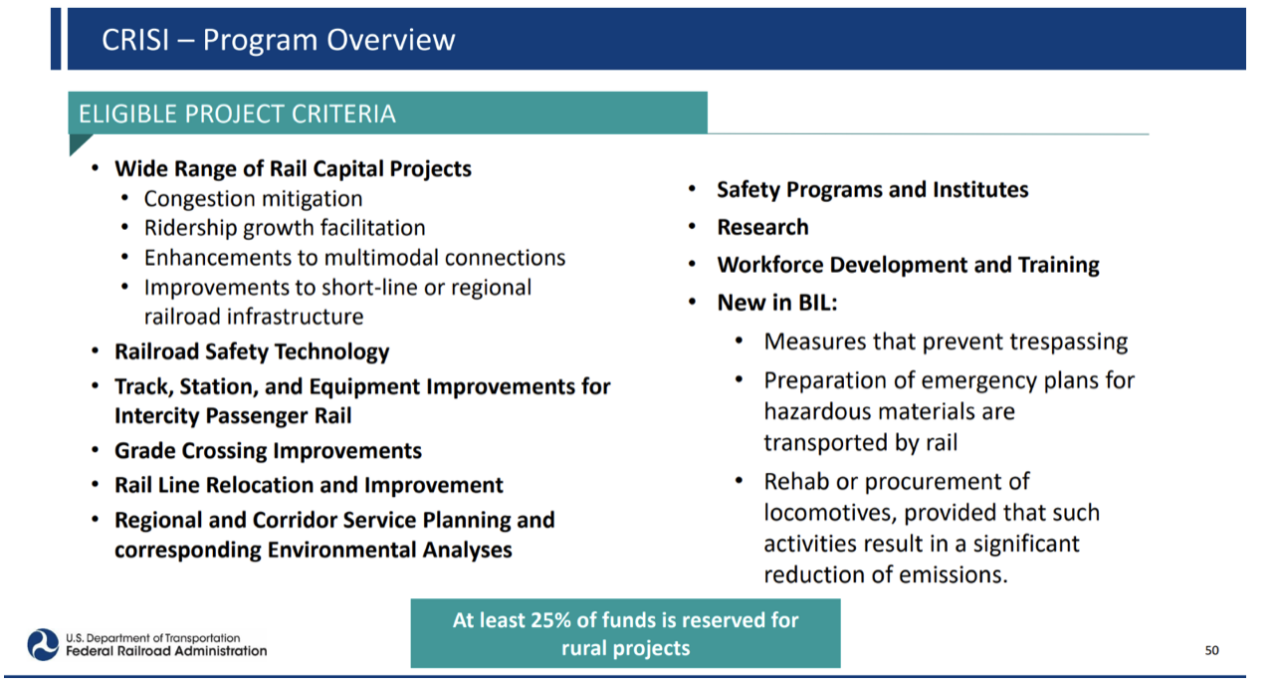
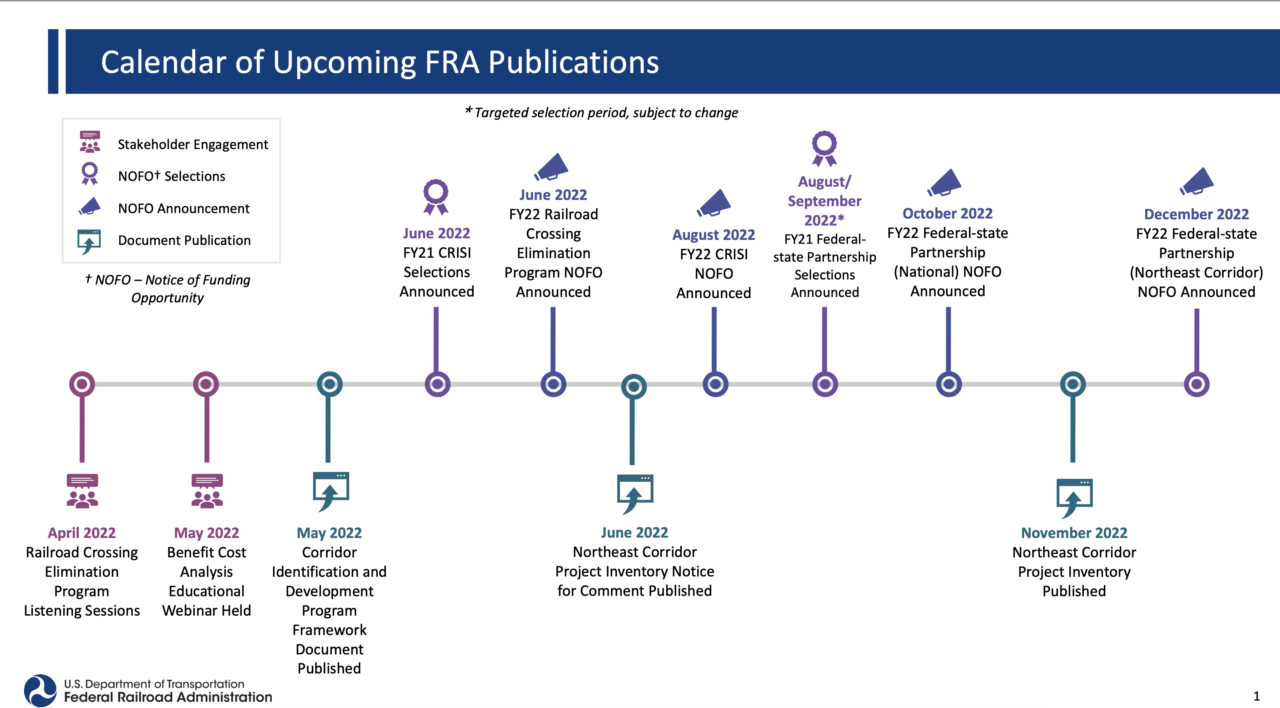
If your city is not ready to go after a grant on their own, USDOT’s Federal Highway Administration also provides funds to State Departments of Transportation through the Railway-Highway Crossings (Section 130) Program for the elimination of hazards at railway-highway crossings. From 2000 to 2019, this program is credited with a 32 percent reduction in fatalities at crossings. These funds are distributed by formula to your state, and each state’s FY22 allocation is listed here. Most states open applications or solicitations to access these funds. The Section 130 program funds are eligible for projects at all public crossings including roadways, bike trails and pedestrian paths, but 50 percent is dedicated for the installation of protective devices at crossings. Congress specifically has made grade crossings projects that eliminate hazards posed by blocked crossings due to idling trains eligible. However, the Section 130 program doesn’t offer major construction solutions, such as overpasses or underpasses.
Through these federal rail safety programs cities, towns and villages will be able to eliminate the deaths that occur at dangerous rail crossings in their communities.
Projects Eligible for the New Rail Crossing Elimination Grants
America’s new National Roadway Safety Strategy follows the “Safe System” approach which works by building and reinforcing multiple layers of protection into our infrastructure to: 1) prevent crashes from happening in the first place and 2) minimize the harm caused to those involved when crashes do occur. When humans make mistakes, the consequences should not be deadly.
For rail crossings, most communities using the “Safe Systems” approach are looking for a way to deconflict the road and pedestrian traffic with the trains coming through or to improve the safety at the crossing through upgrades.
To reach that goal, the following are key ways that the RCE grants can be used:
- Over or Under: Railroad track and road grade separation through the use of bridges, embankment, tunnel or combination.
- Move It: Relocating a railroad track.
- Upgrade: Installing or improving signals, signs or protective devices.
- Plan: Planning grants which include the environmental review and design of an eligible project. Not less than 3 percent of the RCE grant funding is for planning grants unless it is in a rural or tribal area where up to 25 percent can be used.
- Technology: Other means to improve the safety if related to the mobility of people and goods at highway-rail grade crossings, including technology solutions.
How Cities are Making Rail Crossings Safer
Nappanee, IN
In the City of Nappanee, IN, a Safer Railroad Crossings project aims to improve seven at-grade crossings along a 2.5-mile rail corridor. The corridor work includes the installation of Constant Warning Time Circuitry, roadway modifications (including channelization, medians, curbing, or closing commercial driveways), and improved vertical geometry for low-ground-clearance vehicle crossings.
Once completed, these seven public crossings will meet all the requirements to establish a Quiet Zone. Quiet Zones are public highway-rail grade crossings that do not require locomotives to sound their horns, if certain safety criteria have been met at that crossing location. The $1.4 million dollar funding for the project was also designated to develop a program to educate drivers about local safety issues related to crossings, specifically through outreach materials on suicide prevention.
Tulare, CA
The City of Tulare, CA, received $2.2 million dollars to engage in a project that enhances grade crossing safety by improving pedestrian and vehicle safety. Their improvements include elements such as pre-signal for eastbound traffic, advanced pre-emption, traffic signal upgrades, upgrades to the rail crossing infrastructure and signal infrastructure, new pedestrian facilities that are ADA-compliant, new striping, and minor pavement improvements at the crossing.
Springfield, IL
The Springfield Rail Improvements Project in Springfield, IL addresses issues of public safety, traffic congestion, community livability and commercial development in a comprehensive effort. The project covers numerous improvements but will consolidate rails and remove barriers to commercial activity and residential connectivity and create a quiet zone.
The city received previous federal funding up to $10 million dollars to replace two existing rail bridges with double-track bridges and to close an existing crossing. The project also constructs double-track bridges for the relocated Union Pacific tracks and includes grading, drainage, and track work.
Chelsea, MA
A project in the City of Chelsea, MA, looks for a safer 1.47-mile corridor on the MBTA’s East Route Main Line by installing four-quadrant gates, grade crossing warning signage, and upgrading pavement markings at six railroad crossings. This particular corridor carries approximately 70 freight and passenger trains per day. These grade crossing safety measures will reduce the FRA Quiet Zone Risk Index by over 80 percent and will allow the city to finally establish a quiet zone once complete.
Long Island, NY
A partnership between Long Island Rail Road (LIRR) and Waze provided a technological solution to addressing railroad crossing incidents encountered by drivers of motor vehicles. Together, LIRR and Waze developed a safety feature that alerts Waze app users to upcoming grade crossings. This solved the growing issue of an increase in drivers reporting that they had turned onto railroad tracks while trying to follow directions from a navigation app. The solution ensured grade crossings were clearly and accurately noted which helped increase driver awareness and safety, particularly for drivers who were not familiar with the area.
Get Ready to Apply
Pick the Rail Program that Fits Your Project and Timing
Each of the available rail crossing eligible programs offers a different opportunity with slightly different partners and grant dollar amounts. While it may be frustrating that each program is a little different, it also means there are more opportunities to fund and advocate for your project.
Timing of release of federal grants is also important, but if you miss one cycle, remember there are five years of BIL programs. NLC expects to see the RCE program this June in addition to hearing when the next round of CRISI will open, yet the INFRA cycle has already closed for now.
Check out the Federal Rail Administration’s BIL homepage for recent updates on webinars and notice of funding opportunities. General information about programs can be found on the FRA’s Competitive Discretionary Grant Programs webpage. You can also sign up to the FRA’s mail list here, and receive future notifications for webinars, updates, and notice of funding opportunities. This past April, the FRA held listening sessions to gather input from stakeholders on the implementation of the Railroad Crossing Elimination Program.
Find Partners to Support Your Application
To make a grant application stronger, local leaders can start identifying potential partners (who are all listed clearly in the BIL legislation and on program websites), but your most important partner is likely the railroad owner who should be equally invested in upgrading the safety at the intersections. If you’re not sure who to contact, use this Association of American Railroads roster of state contacts to find the right starting point.
Additionally, key stakeholders include state departments of transportation, county engineers, metropolitan and rural planning officials, public safety first responders, hospitals and medical providers, private sector partners and nearby community groups. When working with community partners, municipal leaders should think about how to engage historically underrepresented communities that have traditionally been left out of transportation decision-making processes or were previously impacted by a federal infrastructure investment that historically “on the wrong side of the tracks.” Be diligent that the outreach processes meet the community where they are today with helpful strategies that encourage real participation and input.
| Program Name | Local | State | MPO | Tribe | Public Authority | Can Locals apply alone? | Can Locals apply with eligible partners? | Anticipated NOFO release date |
| Consolidated Rail Infrastructure and Safety Improvement Grants CRISI | ✔ | ✔ | ✔ | ✔ | ✔ | Yes | Yes | NOFO Open in Summer 2022 |
| Railroad Crossing Elimination Program | ✔ | ✔ | ✔ | ✔ | ✔ | Yes | Yes | NOFO Open in Summer 2022 |
| Railway-Highway Crossings (Section 130) Program | ✔ | No (Cities should work with their states) | No | Guidance Released in Spring 2022 | ||||
| Rail Vehicle Replacement Grants | ✔ | ✔ | ✔ | Yes | Yes* | NOFO Open in Summer 2022 | ||
| Federal-State Partnership for Intercity Passenger Rail Grants | ✔ | ✔ | ✔ | ✔ | ✔ | Yes | Yes | NOFO Open in Fall 2022 |
| Restoration & Enhancement Grant Program | ✔ | ✔ | ✔ | ✔ | ✔ | Yes | Yes | NOFO Open in Summer 2022 (tentative) |
Confirm your City’s Unique Federal Identifier
Most cities have a point of contact in charge of their federal grant credentials which will be required to submit any application to USDOT. Starting April 4, 2022, the Data Universal Numbering System (DUNS) number which has traditionally been used to apply for grants on grants.gov was replaced with the Unique Entity Identifier (UEI). If your city, town or village is already registered with SAM.gov an UEI number has already been assigned and is viewable at SAM.gov. If your municipality does not have a UEI number yet, U.S. agencies are encouraging entities to apply for an UEI number immediately in order to be able to apply for grants.
